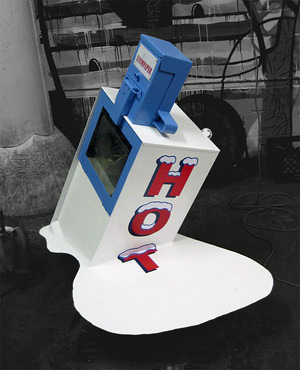Global Warming Is Here to Stay
Excuse me, folks, but the weather is trying to tell us something. Listen carefully, and you can almost hear a parched, raspy voice whispering, "What part of 'hottest month ever' do you people not understand?"
WASHINGTON — Excuse me, folks, but the weather is trying to tell us something. Listen carefully, and you can almost hear a parched, raspy voice whispering, “What part of ‘hottest month ever’ do you people not understand?”
According to the National Oceanic and Atmospheric Administration, July was indeed the hottest month in the contiguous United States since record-keeping began more than a century ago. That distinction was previously held by July 1936, which came at the height of the Dust Bowl calamity that devastated the American heartland.
The average temperature last month was 77.6 degrees — a full 3.3 degrees warmer than the 20th-century norm for July. This follows the warmest 12-month period ever recorded in the United States, and it continues a long-term trend that is obvious to all except those who stubbornly close their eyes: Of the 10 hottest years on record, nine have occurred since 2000.
James E. Hansen, who heads NASA’s Goddard Institute for Space Studies, summed it up in a piece he wrote for The Washington Post last week: “The future is now. And it is hot.”
Hansen wrote that when he testified before Congress in 1988 and painted a “grim picture” of the consequences of climate change, he was actually being too optimistic. His projections of how rapidly temperatures would rise were accurate, he wrote, but he “failed to fully explore how quickly that average rise would drive an increase in extreme weather.”
Yes, scientists are finally asserting a direct connection between long-term climate trends and short-term weather events. This was always a convenient dodge for climate change deniers. There might be a warming trend over decades or centuries, they would say, but no specific heat wave, hurricane or hailstorm could definitively be attributed to climate change.
“To the contrary, our analysis shows that, for the extreme hot weather of the recent past, there is virtually no explanation other than climate change,” Hansen wrote. “The deadly European heat wave of 2003, the fiery Russian heat wave of 2010 and catastrophic droughts in Texas and Oklahoma last year can each be attributed to climate change.”
Hansen went on, “The odds that natural variability created these extremes are minuscule, vanishingly small. To count on those odds would be like quitting your job and playing the lottery every morning to pay the bills.”
If you won the lottery yesterday, feel free to stop reading. If you didn’t, stick with me a bit longer.
The other escape hatch for deniers is the question of why the Earth’s atmosphere is warming. Yes, there may be climate change, this argument goes, but we know there have been Ice Ages in the past and other big temperature variations. What we’re witnessing is due to natural processes — perhaps some long-term cycle we are too feeble to comprehend. You can’t prove that human activity, specifically the burning of fossil fuels, is to blame.
A Gallup poll last year found that this view — essentially, “You can’t pin it on our SUVs” — has been gaining traction in this country, even as it has become discredited elsewhere. Between 2007 and 2010, the percentage of U.S. adults who believed human activity contributed to warming declined from 60 percent to 48 percent.
I wrote a column last fall when University of California at Berkeley physicist Richard Muller, one of the leading skeptics on climate change, reversed field and announced that his own careful research indicated the atmosphere is, indeed, warming rapidly. Last week, Muller announced in The New York Times that “I’m now going a step further: Humans are almost entirely the cause.”
Muller, who heads the Berkeley Earth Surface Temperature project, wrote that he and his team tried correlating the observed warming with phenomena such as solar activity and volcanic eruptions. “By far the best match was to the record of atmospheric carbon dioxide,” he wrote.
The amount of heat-trapping carbon dioxide in the atmosphere is rising because of human activity — the burning of fossil fuels. The more we burn, Muller wrote, the faster the atmosphere will warm.
And the crazier the weather will get.
We can’t do anything about the greenhouse gases we’ve already spewed into the atmosphere, but we can minimize the damage we do in the future. We can launch a serious initiative to develop and deploy alternative sources of energy. We can decide what kind of environment we leave to our grandchildren.
I’d like to hear President Obama and Mitt Romney talk about the future of the planet. What about you?
Eugene Robinson’s e-mail address is eugenerobinson(at)washpost.com.
© 2012, Washington Post Writers Group
Your support matters…Independent journalism is under threat and overshadowed by heavily funded mainstream media.
You can help level the playing field. Become a member.
Your tax-deductible contribution keeps us digging beneath the headlines to give you thought-provoking, investigative reporting and analysis that unearths what's really happening- without compromise.
Give today to support our courageous, independent journalists.






You need to be a supporter to comment.
There are currently no responses to this article.
Be the first to respond.